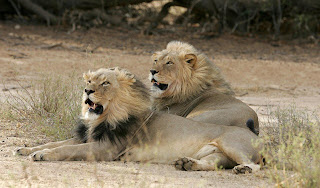It is not under a Camelthorn tree that we seek shelter, but a Honey Mesquite, that provides some welcome shade. The Mesquite is not indigenous to this part of the world, but is found in Namibia. It has been accused of being too thirsty, and depleting valuable water resources, but I am grateful for the hospitality of this tree with its attractive light green fronds.
We set up camp in the heat which saps our energy. Each couple erected a dome tent, set out bedding and stretchers, and the Mullins provided a rather posh gazebo, which served as the kitchen area. Check out this photo taken by Dave Mullin, of our rather luxurious camp site:
Our Nossob campsite. Photo: D.Mullin

Jackals are carnivores, and belong to the same canid family as Wild Dogs and foxes. Of all the creatures in the Kalahari, these are the most wily and cunning. During the springbok lambing season, the jackals have been known to hunt in packs, and to run through the herd of springbok, in order to distract a mother, and snatch a lamb. They will also hunt springhares, rats, small reptiles, beetles, locusts and termites.
Jackals are also scavengers, and they will wait for opportunities when predators are feeding on a carcass. Lions will sometimes kill a jackal that has become too bold, and leopards will also attack them. However, the jackal will not approach a cheetah on a kill, as the cheetah is too swift, and will chase the jackal to kill it. They are not afraid of hyenas, and will often harass the hyenas, by nipping their hind legs and then darting away.
 Dave and Joy spent time in the hide at Nossob, watching the jackals trying to catch the doves, that had come down to drink at the water-hole. This photo capturing the action of a failed attempt to procure a meal, was taken by Dave Mullin.
Dave and Joy spent time in the hide at Nossob, watching the jackals trying to catch the doves, that had come down to drink at the water-hole. This photo capturing the action of a failed attempt to procure a meal, was taken by Dave Mullin.
The jackals were patrolling all the campsites while we ate a delicious supper of lamb chops and vegetables done on the braai. Joy had chopped and sliced red cabbage, baby leeks, carrots, spring onions and brinjals ( aubergine or egg-plant ); wrapped everything in a tinfoil parcel, and placed it on fire. Night had fallen, and two eyes glowed in the dark. I did not see the opportunistic jackal snatch two lamb chops for his supper. I was not a "happy camper" !
There was much jackal yipping and yowling during the night. The marauding jackals were raiding the other campers. There was much shouting and cursing, as goods were sneaked away. I tossed about on the camping stretcher, and finally sank into a deep sleep. In the early hours, I was awokened by a deep, throaty roar. The king of the Kalahari was exercising his vocal chords...



























